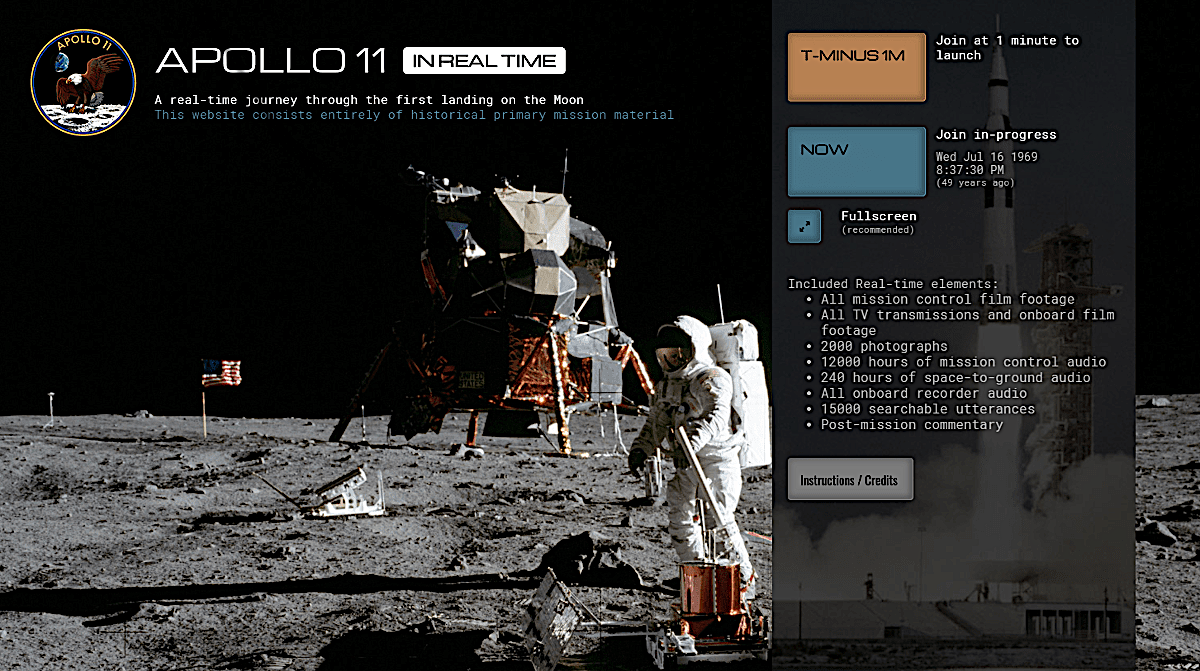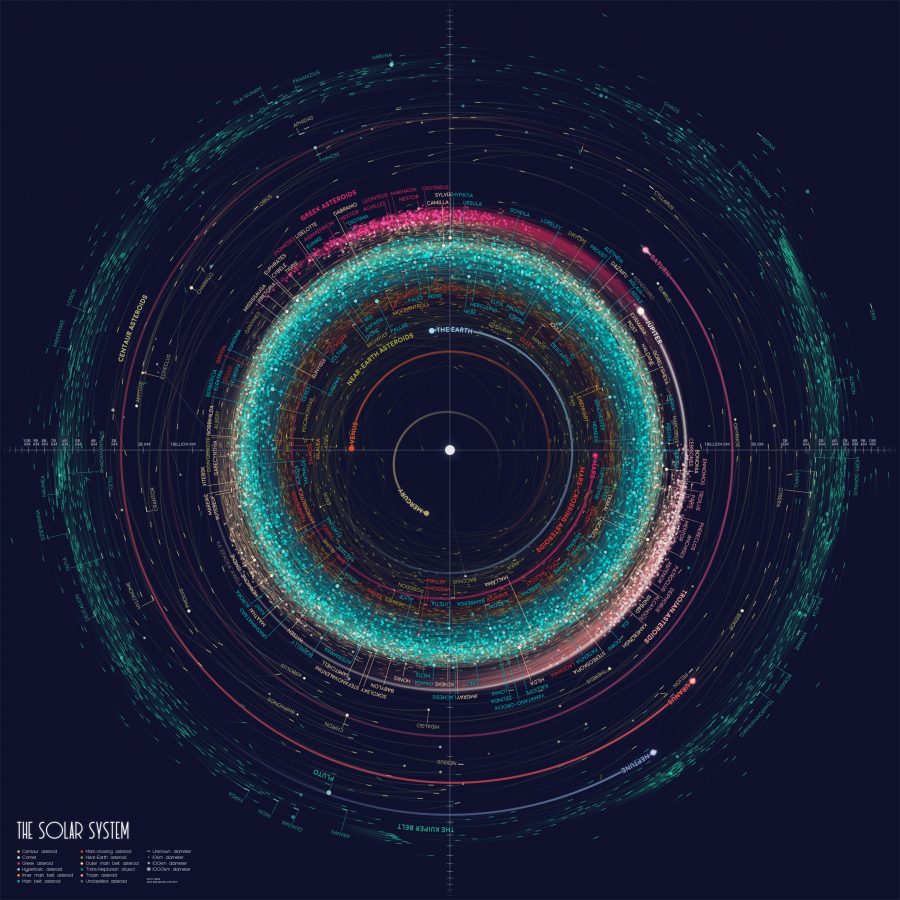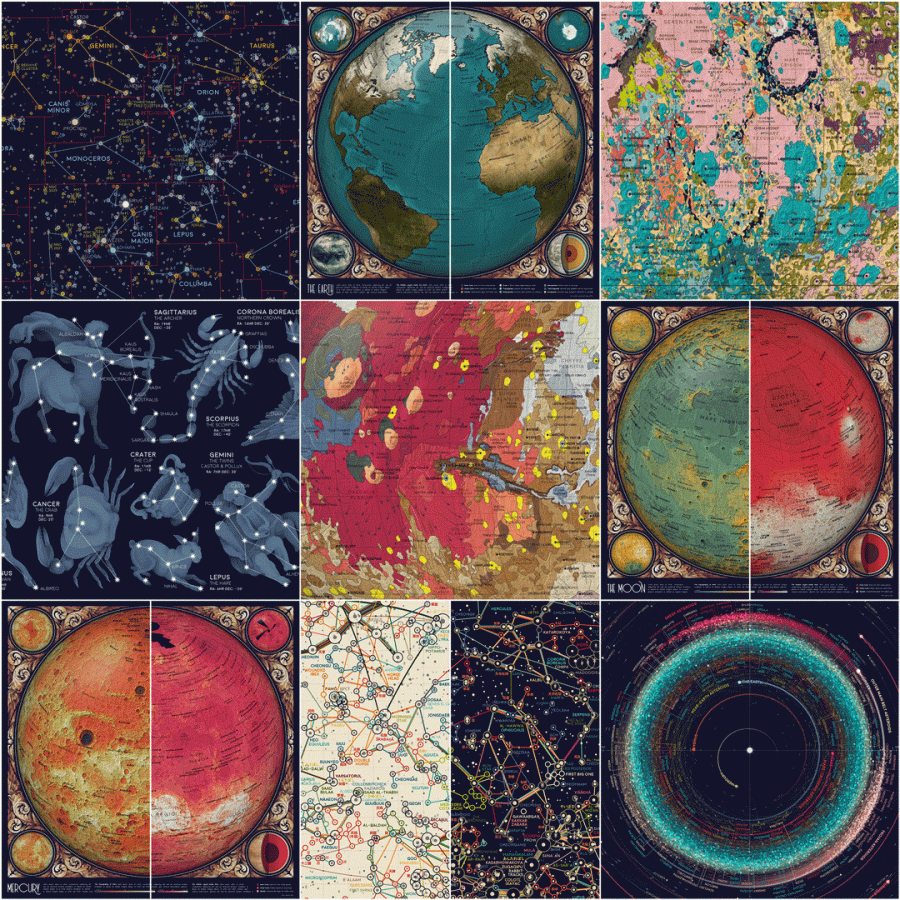[Most Recent Entries] [Calendar View]
Thursday, June 20th, 2019
| Time | Event |
| 8:00a | Apollo 11 in Real Time: A New Web Site Lets You Take a Real-Time Journey Through First Landing on the Moon
It only took four days. Four, long, nail-biting days where anything could go wrong, with so many fraught steps, between the liftoff of Apollo 11 and Neil Armstrong leaving the first footprint on the moon. And now fifty years stretches between us and those days, very brief days indeed, where the population of the earth came together over one stunning act of science and ingenuity. Yes, it was an American flag planted on the moon, but it was one giant leap for mankind. This July we might want to revisit those warm feelings about humanity in what feels like a diminished world, and look in wonder at the stars again. The Apollo In Real Time website is here to do just that. Now you can go to this website, sit back and watch as the entire Apollo 11 mission unfolds in real time. It’s a beautifully designed website, looking like a control panel from NASA itself. There are three timelines up top to show exactly where we are over the entire course of the nine days, from launch to re-entry. On the left there is a summary of Mission Status, including velocity and distance from the earth. Below is a real time transcript between mission control and the craft. And a strip down the middle offers over 40 different channels of audio from all the main and not-so-main players, a total of 11,000 hours, most of which has never been heard before. Where available there’s film and video footage, along with photographs, a lot of it taken by the astronauts themselves, and all in the best possible quality. So if you think you’ve seen this footage over and over, think again. (Side note: I find just listening to the sounds of mission control is very relaxing. I'm thinking a lot of you will agree.) The site is the creation of Ben Feist, a software engineer and historian at NASA, along with his team of collaborators, who undertook something similar a few years ago for Apollo 17. via Kottke.org Related Content: NASA Digitizes 20,000 Hours of Audio from the Historic Apollo 11 Mission: Stream Them Free Online Watch the Original TV Coverage of the Historic Apollo 11 Moon Landing: Recorded on July 20, 1969 The Source Code for the Apollo 11 Moon Landing Mission Is Now Free on Github Ted Mills is a freelance writer on the arts who currently hosts the artist interview-based FunkZone Podcast and is the producer of KCRW's Curious Coast. You can also follow him on Twitter at @tedmills, read his other arts writing at tedmills.com and/or watch his films here. Apollo 11 in Real Time: A New Web Site Lets You Take a Real-Time Journey Through First Landing on the Moon is a post from: Open Culture. Follow us on Facebook, Twitter, and Google Plus, or get our Daily Email. And don't miss our big collections of Free Online Courses, Free Online Movies, Free eBooks, Free Audio Books, Free Foreign Language Lessons, and MOOCs. |
| 11:00a | Stanford’s Robert Sapolsky Demystifies Depression, Which, Like Diabetes, Is Rooted in Biology We know that depression affects people from all walks of life. Rich. Poor. Celebs. Ordinary Joes. Young. Old. But, somehow after the death of Robin Williams, there's a renewed focus on depression, and my mind turned immediately to a lecture we featured on the site way back in 2009. The lecture is by Robert Sapolsky, a Stanford biologist, who has a talent for making scientific subjects publicly accessible. A recipient of the MacArthur genius grant, Sapolsky notes that depression --- currently the 4th greatest cause of disability worldwide, and soon the 2nd -- is deeply biological. Depression is rooted in biology, much as is, say, diabetes. As the lecture unfolds, you will see how depression changes the body. When depressed, our brains function differently while sleeping, our stress response goes way up 24/7, our biochemistry levels change, etc. You will see that biology is at work. Sapolsky is one compelling teacher. So you might not want to miss his Stanford course, Introduction to Human Biology. It's equally worth your time. You can always find it housed in our collection 1,300 Free Online Courses from Top Universities. Note: An earlier version of this post appeared on the site in August, 2014. Would you like to support the mission of Open Culture? Please consider making a donation to our site. It's hard to rely 100% on ads, and your contributions will help us continue providing the best free cultural and educational materials to learners everywhere. Also consider following Open Culture on Facebook and Twitter and sharing intelligent media with your friends. Or sign up for our daily email and get a daily dose of Open Culture in your inbox. Related Content: Exercise May Prove an Effective Natural Treatment for Depression & Anxiety, New Study Shows Stephen Fry on Coping with Depression: It’s Raining, But the Sun Will Come Out Again Stanford’s Robert Sapolsky Demystifies Depression, Which, Like Diabetes, Is Rooted in Biology is a post from: Open Culture. Follow us on Facebook, Twitter, and Google Plus, or get our Daily Email. And don't miss our big collections of Free Online Courses, Free Online Movies, Free eBooks, Free Audio Books, Free Foreign Language Lessons, and MOOCs. |
| 2:00p | The Atlas of Space: Behold Brilliant Maps of Constellations, Asteroids, Planets & “Everything in the Solar System Bigger Than 10km”
A great deal remains to be learned about our solar system, but a great deal has already been learned about it as well. Yet huge amounts of data such as those produced by outer-space research so far can't do much for us unless we can interpret them. Luckily, the age of the internet has made possible unprecedentedly easy access to data as well as unprecedentedly easy distribution of interpretations of that data. Eleanor Lutz, a biology graduate student at the University of Washington and the creator of the science illustration blog Tabletop Whale, has taken advantage of both conditions to wow her ever-growing fan base with her maps of the realms beyond Earth.
"Atlas of Space, her latest project, is all about the solar system," writes Wired's Sara Harrison. "She plumbed the depths of publicly available data sets from agencies like NASA and the US Geological Survey and used them to create vivid maps of constellations, asteroids, and planets. In one image, luminescent bands of fuchsia and aquamarine asteroids swirl around the bright, white point of the Sun. In another, Earth seems to pulsate as an animation of Arctic sea ice shows how it extends down the continents during the winter and then retracts back to the poles in summer." [Error: Irreparable invalid markup ('<div [...] http://cdn8.openculture.com/>') in entry. Owner must fix manually. Raw contents below.] <p><img class="alignnone wp-image-1066163 size-full" src="https://cdn8.openculture.com/2019/06/19194820/SpaceAtlas1-e1561007085236.jpg" alt="" width="320"/></p>
<p>A great deal remains to be learned about our solar system, but a great deal has already been learned about it as well. Yet huge amounts of data such as those produced by outer-space research so far can't do much for us unless we can interpret them. Luckily, the age of the internet has made possible unprecedentedly easy access to data as well as unprecedentedly easy distribution of interpretations of that data. Eleanor Lutz, a biology graduate student at the University of Washington and the creator of the science illustration blog <a href="http://tabletopwhale.com/">Tabletop Whale</a>, has taken advantage of both conditions to wow her ever-growing fan base with her maps of the realms beyond Earth.</p>
<p><img class="alignnone wp-image-1066164 size-full" src="https://cdn8.openculture.com/2019/06/19194833/SpaceAtlas2-e1561007394495.gif" alt="" width="320"/></p>
<p>"<a href="http://tabletopwhale.com/2019/06/03/an-atlas-of-space.html">Atlas of Space</a>, her latest project, is all about the solar system," <a href="https://www.wired.com/story/these-sumptuous-images-give-deep-space-data-an-old-world-look/">writes <em>Wired</em>'s Sara Harrison</a>. "She plumbed the depths of publicly available data sets from agencies like NASA and the US Geological Survey and used them to create vivid maps of constellations, asteroids, and planets. In one image, luminescent bands of fuchsia and aquamarine asteroids swirl around the bright, white point of the Sun. In another, Earth seems to pulsate as an animation of Arctic sea ice shows how it extends down the continents during the winter and then retracts back to the poles in summer."</p>
<div class="oc-center-da"http://cdn8.openculture.com/>
<p>Lutz plans to release all the images she has created for her Atlas of Space over the next few weeks, along with instructions teaching readers how to create similar illustrations themselves. In <a href="http://tabletopwhale.com/2019/06/03/an-atlas-of-space.html">her introductory post to the project</a>, she promises "an animated map of the seasons on Earth, a map of Mars geology, and a map of everything in the solar system bigger than 10km."</p>
<p><img class="alignnone wp-image-1066165 size-full" src="https://cdn8.openculture.com/2019/06/19194847/SpaceAtlas3-e1561007592659.jpg" alt="" width="320"/></p>
<p>Lutz also briefly describes her plans to write about everything from "working with Digital Elevation Models (DEMs) in Bash and Python" to "using the NASA HORIZONS orbital mechanics server and scraping internet data" to "updating vintage illustrations and painting in Photoshop." That last element has already made the project particularly eye-catching: you'll notice the Atlas of Space pages published so far, <a href="http://tabletopwhale.com/2019/06/10/the-solar-system.html">"An Orbit Map of the Solar System"</a> and <a href="http://tabletopwhale.com/2019/06/17/a-topographic-map-of-mercury.html">"A Topographic Map of Mercury,"</a> both possess a strong retro design sensibility, though each of a completely different kind. <a href="http://www.openculture.com/2019/05/the-strikingly-beautiful-maps-charts-that-fired-the-imagination-of-students-in-the-1880s.html">Levi Walter Yaggy</a> would be proud — and no doubt astonished by just how much more information we've managed to gather about the solar system over the past 130 years.</p>
<p><a href="https://www.wired.com/story/these-sumptuous-images-give-deep-space-data-an-old-world-look/">via Wired</a></p>
<p><strong>Related Content:</strong></p>
<p><a href="http://www.openculture.com/2019/05/the-strikingly-beautiful-maps-charts-that-fired-the-imagination-of-students-in-the-1880s.html">The Strikingly Beautiful Maps & Charts That Fired the Imagination of Students in the 1880s</a></p>
<p><a href="http://www.openculture.com/2013/09/google-earth-engine.html">A Planetary Perspective: Trillions of Pictures of the Earth Available Through Google Earth Engine</a></p>
<p><a href="http://www.openculture.com/2011/05/3d_map_of_universe_captures_43000_galaxies.html">3D Map of Universe Captures 43,000 Galaxies</a></p>
<p><a href="http://www.openculture.com/2018/09/a-massive-knitted-tapestry-of-the-galaxy.html">A Massive, Knitted Tapestry of the Galaxy: Software Engineer Hacks a Knitting Machine & Creates a Star Map Featuring 88 Constellations</a></p>
<p><a href="http://www.openculture.com/2018/11/study-solar-system-using-female-astronomers-handmade-1876-quilt.html">The Solar System Quilt: In 1876, a Teacher Creates a Handcrafted Quilt to Use as a Teaching Aid in Her Astronomy Class</a></p>
<p><a href="http://www.openculture.com/2015/09/the-solar-system-drawn-amazingly-to-scale-across-7-miles-of-nevadas-black-rock-desert.html">The Solar System Drawn Amazingly to Scale Across 7 Miles of Nevada’s Black Rock Desert</a></p>
<p><em>Based in Seoul, <a href="http://blog.colinmarshall.org/">Colin Marshall</a> writes and broadcasts on cities, language, and culture. His projects include the book </em>The Stateless City: a Walk through 21st-Century Los Angeles <em>and the video series </em><a href="https://vimeo.com/channels/thecityincinema">The City in Cinema</a><em>. Follow him on Twitter at <a href="https://twitter.com/#%21/colinmarshall">@colinmarshall</a>, on <a href="https://www.facebook.com/colinmarshallessayist">Facebook</a>, or on <a href="https://www.instagram.com/colinmarshallseoul/">Instagram</a>.</em></p>
<!-- permalink:http://www.openculture.com/2019/06/the-atlas-of-space.html--><p><a rel="nofollow" href="http://www.openculture.com/2019/06/the-atlas-of-space.html">The Atlas of Space: Behold Brilliant Maps of Constellations, Asteroids, Planets & “Everything in the Solar System Bigger Than 10km”</a> is a post from: <a href="http://www.openculture.com">Open Culture</a>. Follow us on <a href="https://www.facebook.com/openculture">Facebook</a>, <a href="https://twitter.com/#!/openculture">Twitter</a>, and <a href="https://plus.google.com/108579751001953501160/posts">Google Plus</a>, or get our <a href="http://www.openculture.com/dailyemail">Daily Email</a>. And don't miss our big collections of <a href="http://www.openculture.com/freeonlinecourses">Free Online Courses</a>, <a href="http://www.openculture.com/freemoviesonline">Free Online Movies</a>, <a href="http://www.openculture.com/free_ebooks">Free eBooks</a>, <a href="http://www.openculture.com/freeaudiobooks">Free Audio Books</a>, <a href="http://www.openculture.com/freelanguagelessons">Free Foreign Language Lessons</a>, and <a href="http://www.openculture.com/free_certificate_courses">MOOCs</a>.</p>
<div class="feedflare">
<a href="http://feeds.feedburner.com/~ff/OpenCulture?a=BofD3CUdXyI:iuLcx9Ec6YM:yIl2AUoC8zA"><img src="http://feeds.feedburner.com/~ff/OpenCulture?d=yIl2AUoC8zA" border="0"></img></a> <a href="http://feeds.feedburner.com/~ff/OpenCulture?a=BofD3CUdXyI:iuLcx9Ec6YM:V_sGLiPBpWU"><img src="http://feeds.feedburner.com/~ff/OpenCulture?i=BofD3CUdXyI:iuLcx9Ec6YM:V_sGLiPBpWU" border="0"></img></a> <a href="http://feeds.feedburner.com/~ff/OpenCulture?a=BofD3CUdXyI:iuLcx9Ec6YM:gIN9vFwOqvQ"><img src="http://feeds.feedburner.com/~ff/OpenCulture?i=BofD3CUdXyI:iuLcx9Ec6YM:gIN9vFwOqvQ" border="0"></img></a> <a href="http://feeds.feedburner.com/~ff/OpenCulture?a=BofD3CUdXyI:iuLcx9Ec6YM:qj6IDK7rITs"><img src="http://feeds.feedburner.com/~ff/OpenCulture?d=qj6IDK7rITs" border="0"></img></a> <a href="http://feeds.feedburner.com/~ff/OpenCulture?a=BofD3CUdXyI:iuLcx9Ec6YM:I9og5sOYxJI"><img src="http://feeds.feedburner.com/~ff/OpenCulture?d=I9og5sOYxJI" border="0"></img></a>
</div><img src="http://feeds.feedburner.com/~r/OpenCulture/~4/BofD3CUdXyI" height="1" width="1" alt=""/> |
| << Previous Day |
2019/06/20 [Calendar] |
Next Day >> |




